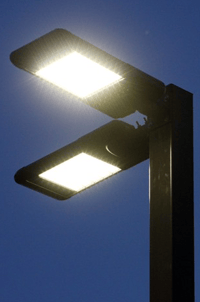 When deciding to upgrade your parking lot lighting from traditional high intensity discharge (HID) lighting to LED make sure you consider adding controls to maximize savings, further reduce the break-even point on your investment, and optimize the sustainability in your workplace. There are many ways LED lights can be controlled and scheduled. Below are five common methods of how to control parking lot lights when using LED lighting. These options can either be installed as a stand-alone system or can be combined to increase the energy savings even more.
When deciding to upgrade your parking lot lighting from traditional high intensity discharge (HID) lighting to LED make sure you consider adding controls to maximize savings, further reduce the break-even point on your investment, and optimize the sustainability in your workplace. There are many ways LED lights can be controlled and scheduled. Below are five common methods of how to control parking lot lights when using LED lighting. These options can either be installed as a stand-alone system or can be combined to increase the energy savings even more.
Time Clocks
There are two different kinds of time clocks. There is analog version that is very simple and straightforward to use—they have a dial with times listed and the user sets an “on arrow” and an “off arrow” to the times they wish the parking lot lights to turn on and off. This is a very cost-effective option, but often requires the user to make adjustments as sunset and sunrise times change.
The better option for LED parking lot lighting time clocks is the digital time clock. These have a higher upfront cost, but they take into consideration changing sunrise and sunset times eliminating the need for the end user to make adjustments after installation.
A good combination to the time clock is adding a photocell override. They ensure that the parking lot lights can only turn on during the set time from the time clock, and the light level outside is dark enough to warrant needing the parking lot lights are "on."
Photocells
Photocells can either be installed on every fixture or as part of a contactor that can control parking lot lights through a bank of lights. Utilizing photocells takes out the guesswork of turning the parking lot lights on or off. Photocells work off the basic principle that if it’s dark outside, your parking lot lights turn on, and if it’s bright outside, the photocells keep them off. Photocells have the added benefit of being able to turn the parking lot lights on during the day if a storm comes in, or other
natural occurrences happen that may require needing the lights turned on.

When retrofitting an existing lot, installing a photocell on every fixture is easier for the installation process, but creates more possibilities of issues and maintenance down the road. Using a photocell to control a contactor is the preferred way to utilize the component.
Potential downsides to photocells is that they are typically the weakest points in the system. They also can malfunction if debris or dirt collects on the lens, tricking it into thinking it is always dark outside—leaving your parking lot lights constantly “on.”
Occupancy Sensors
A variety of sensors are available, all with a wide range of controls and options. The basic ones will turn a parking lot light fixture on or off for a preset amount of time. More complex sensors can dim the fixture and gradually bring the light back up to full brilliance or can use a built in daylight harvester to adjust the brightness of the light until the space is lit to a predetermined value.
As a standalone application, each of these sensors will be mounted on every fixture and will work independently of one another turning on as occupants trip one light after the other. A better solution for this is to incorporate the occupancy sensor into a wireless control system. This way the number of sensors can be reduced and banks of lights can now be controlled with a single sensor. Putting the sensor in a wireless control system also will allow the end user to easily make changes to the programming of the sensor.
Programmable Driver
Some drivers have a programming feature called DALI. This allows the driver to be pre-programmed with an on/off schedule or a dimming schedule without needing to add any additional hardware to the fixture. The downside to this type of control is that each driver has to be programmed, which creates additional labor considering some fixtures utilize two drivers. The other downside is that once the driver is programmed, the end user has to physically reconnect the programmer to the driver to make changes.
Wireless Controls
When it comes to parking lot lighting control, wireless controls have the highest upfront cost, but offer users the most options and flexibility. Their upfront cost can often be offset by higher energy savings which lead to thousands of dollars being saved over a 10-year period. Wireless controls often require an additional piece of hardware that is wired into the driver, and they all communicate to one central control unit. These systems can be as basic as turning the lights on or off and dimming, to collecting a full range of data and sending alerts to end users or triggering if-then statements which are programmed into the controller. Changes to system can be done in a single area, or if the system is on a network, changes can be made from anywhere the end user has an internet connection.
Ensuring that the new parking lot LED lights just installed are only turned on when needed is essential in creating a greater ROI and overall savings on energy bills. With all the options available, users have the ability to turn “on” or “off” a light from almost anywhere in the world. Contact us today if you have any more questions about how to control parking lot lights.


